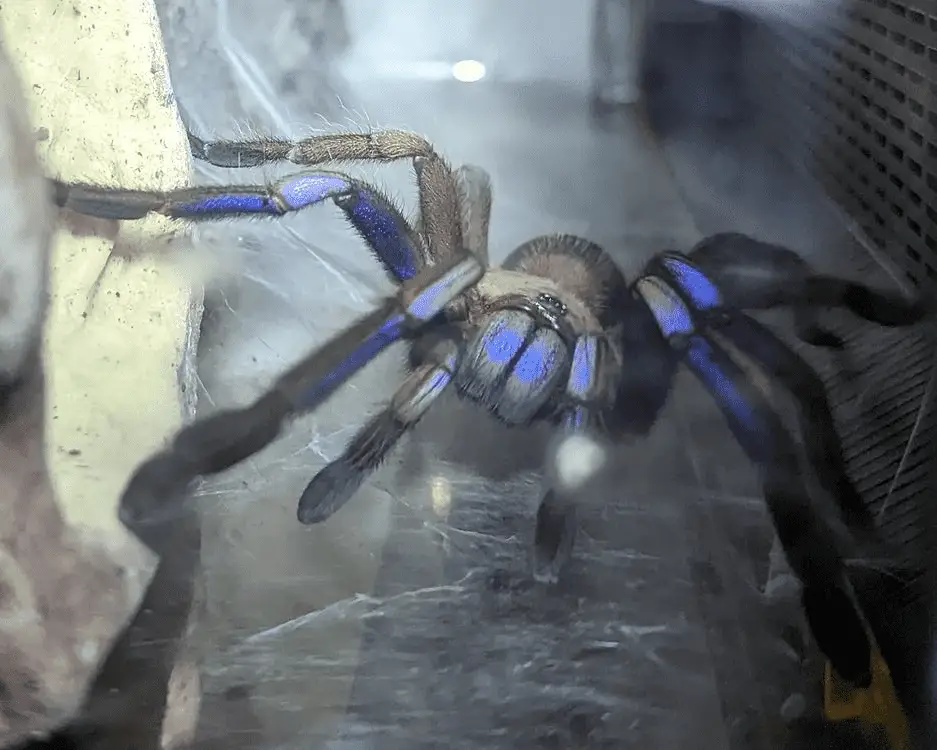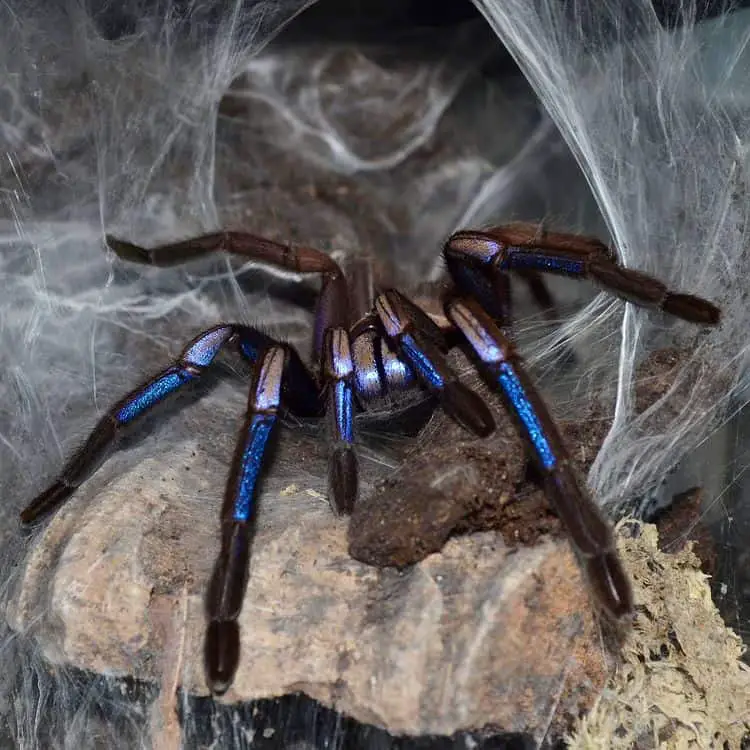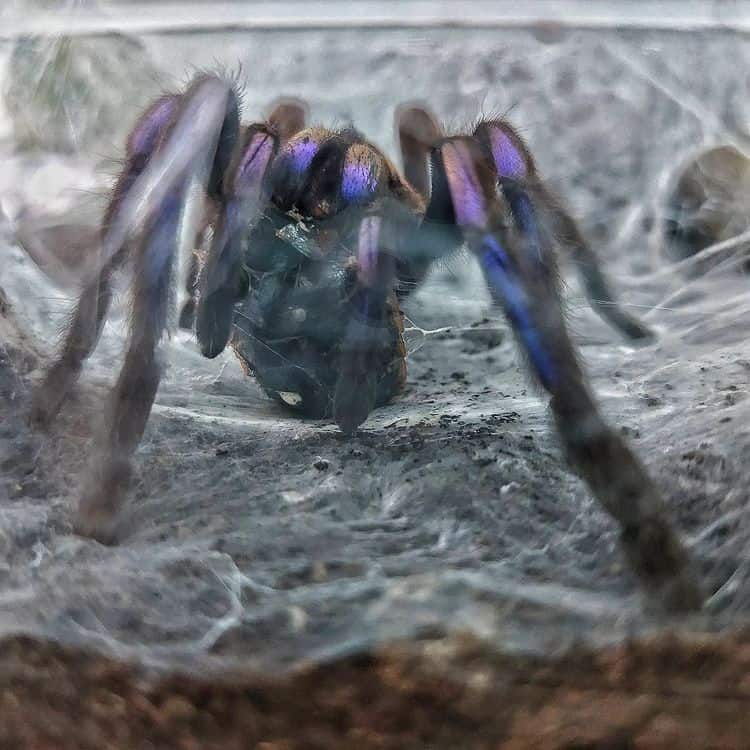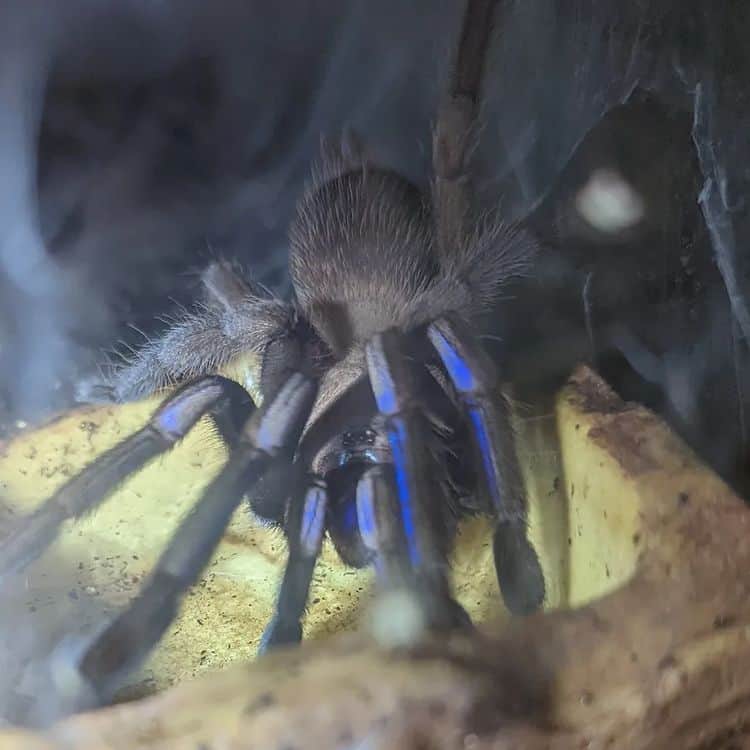The Electric Blue Tarantula (Chilobrachys sp.) is an Old World terrestrial species known for its stunning blue legs, which is where it gets the name from.
This spider has rapidly increased in popularity among tarantula hobbyists because it’s such a beauty, and many people are considering adding one to their collection.
However, if this interesting spider has caught your eye, there are a few things you need to know before adding one to your collection.
Today, we’ll go over everything you need to know about the Electric Blue Tarantula.
Electric Blue Tarantula Care Sheet
| Species Name | Chilobrachys dyscolus |
| Family Name | Theraphosidae |
| Common Names | Electric Blue Tarantula |
| Category | Old World |
| Type | Terrestrial |
| Native Location | Thailand |
| Leg Span | 5″ to 6″ |
| Growth Speed | Medium to fast |
| Urticating Hairs | No |
| Social | Solitary |
| Diet | Crickets, roaches, mealworms |
| Temperature | 75 to 80 degrees Fahrenheit |
| Humidity | 70 to 80% |
| Lifespan | Female: 10 to 12 years / Male: 3 years |
| Experience required | Intermediate/advanced |
| Minimum tank size | 18″x18″x12″ |
Electric Blue Tarantula Overview
The Electric Blue Tarantula is a terrestrial spider that lives on the forest floors of Thailand. They’re semi fossorial, which means that they burrow quite often. In addition, they’re heavy webbers that will span a lot of silk near their burrow.
There are also variants of this spider that are native to Myanmar, Malaysia, Vietnam, and India, but those look slightly different than the Chilobrachys sp.
Appearance & Varieties
One of the reasons why this species has been gaining in popularity lately is its unique appearance. Whereas most species in the Chilobrachys genus are quite dull-looking, The Electric Blue Tarantula is definitely not.
They have a relatively tame brownish carapace and abdomen, but their legs and fangs have a metallic blue tint making this a truly colorful and unique-looking species.
At about 5 to 6 inches in size, they’re not the largest spider, but they’re not particularly tiny either. As is standard with tarantulas, males of this species are smaller than females.
In addition, males are not only smaller, but they’re also different in appearance. Males typically have less blue coloring on their legs and instead have more black coloration.
Price
Electric Blue Tarantulas are not cheap. Slings can easily cost $125, while adult males can cost $150, and females over $200.
The reason why females are more expensive is not only because they have more intriguing colors, but also because they live much longer making them better value for money.
Temperament & Behavior
The Electric Blue Tarantula is not a docile spider. While their initial reaction is to run away from danger, they’re quite a defensive species that will stand their ground if challenged.
As an Old World species they do not have urticating hairs, but they do have fierce fangs that can inject powerful venom. Their venom is significant and can be extremely painful.
On top of that, they’re incredibly quick, so be careful when interacting with one of these spiders to avoid getting bitten.
They’re not suitable for beginners due to their defensive temperament and potent venom.
Since these tarantulas are semi-fossorial they do tend to burrow quite a bit. This is sometimes disappointing because it means that you have less time to enjoy their beautiful electric legs out in the open.
However, they do tend to create burrows at the edges of the enclosure. Since most enclosures are made of glass, you can peek inside their burrow which is also very cool!
On top of that, they’re ferocious eaters with a strong feeding response, which makes dinner time very exciting to witness for many owners.
Handling
It’s not recommended to handle these spiders. Their erratic nature and powerful venom mean that if something goes wrong and they decide to bite you it can end badly.
Not only for you but also for the spider. Getting bitten and being in pain can result in the spider falling on the floor, which can be lethal for them.
Caring for an Electric Blue Tarantula
If you think you’re up for the challenge of caring for these beautiful tarantulas there are a few things that you need to know.
They’re quite low-maintenance and are generally satisfied as long as you provide them with food, a good enclosure, and a high-quality substrate.
Let’s take a closer look at what exactly it is they need to thrive.
Tank setup
As terrestrial species, width is more important than height for their enclosure. Their terrarium should be at least 3 times as wide as their leg span. So, if your spider has a leg span of 6″, they need an enclosure that’s at least 18″ wide.
The Exo Terra 18″x18″x12″ terrarium is a highly recommended enclosure that has the right dimensions for an adult Electric Blue Tarantula. It’s wide and long enough for them to feel at home, while not being too tall to avoid falls if your tarantula decides it wants to climb.
While they typically spend a lot of time in their burrow, it’s a good idea to provide them with a cork bark hide so that they have an alternative option to hide in. You can also spice up their enclosure with some rocks and artificial plants.
Substrate
Since these spiders tend to burrow a lot, they need a layer of substrate that’s thick enough to facilitate this behavior. To do so, make sure that they have a layer of substrate that’s at least 6 inches thick.
Good materials to use for substrate include coconut fiber, peat moss, and vermiculite.
To keep the humidity up, you can also place so sphagnum moss in their enclosure.
Temperature & humidity
When it comes to temperature and humidity it’s always recommended to closely mimic the species’ natural climate. After all, this is what they’re best adjusted to.
In the case of the Electric Blue Tarantula, they’re from a region in Vietnam where it’s quite cold in the winter and warm in the summer. Winter temperatures can dip to 60 degrees Fahrenheit while summer temperatures can reach upwards of 87 degrees.
Of course, we don’t want to expose our eight-legged friends to the extremes of their temperature range. They do best at a temperature of around 75 to 80 degrees but are also perfectly capable of doing well in slightly lower temperatures. As long as you keep the temperature above 70, they’ll be perfectly fine.
As for humidity, aim for around 70 to 80%. Again, slightly lower humidity is not necessarily a dealbreaker for them, but this is the optimal range to shoot for.
To keep the humidity at adequate levels you can give them a larger than average water bowl. The evaporation will help increase the moisture in the air.
Additionally, you can drip water down the side of the tank to make the substrate moist, which will also make the enclosure more humid.
Social
While there are communal tarantula species, the Electric Blue is not one of them. In the wild, they only meet to breed and even that often ends in cannibalism.
To ensure that your spider stays safe make sure that you never put more than one in an enclosure.
Molting
The Electric Blue Tarantula has a medium-fast growth rate and will therefore molt relatively frequently, especially when they’re young.
When they’re about to molt they will refuse food. This is normal and nothing to worry about, they simply do this because it makes the molting process easier. While they’re molting, do not touch or otherwise disturb them.
Once the molting process has been completed, make sure not to feed them for several days to ensure that their fangs have had enough time to harden.
Feeding your Electric Blue Tarantula

These tarantulas have quite an appetite and are ferocious hunters and eaters.
As slings, they should eat flightless fruit flies or cricket legs. As they grow into their juvenile stage, they can start eating live prey. Start with small crickets.
When they’re adults, they can start to eat large crickets and other insects such as mealworms, superworms, or Dubia roaches.
The amount that they should eat depends on a few factors. Females typically eat more than males due to their larger size, and more active specimens eat more than more sedentary ones.
Keep an eye on their abdomen to see if you’re feeding them too much or too little. If their abdomen is getting too large, you might be overfeeding them. If it’s getting smaller, you might not be feeding them enough.
As for drinking, slings can drink drops that you drip down the side of the enclosure while adults can drink from a water bowl that’s placed in their enclosure.
Health & Lifespan
The Electric Blue Tarantula is overall a strong, healthy, and hardy species. In captivity, there’s not much that prevents them from living their full lifespan of 12 years for females and 3 years for males.
There are a few things that can threaten them, but they are simple to prevent. The main threats to them in captivity are spider mites, parasites, mold, and falls.
To prevent spider mites and mold/bacterial growth, make sure to clean their cage when necessary, remove uneaten food, and refresh their water frequently.
Parasites can be avoided by making sure that you do not feed them wild-caught insects.
Falls can be avoided by not handling the species and making sure that their enclosure is not too tall.
Final words: Is the Electric Blue right for you?
The Electric Blue Tarantula’s defensive nature and strong venom mean that they’re not the ideal species for first-time owners. First-timers are better off with more docile species such as the Antilles Pink Toe or the Arizona Blonde.
Intermediate owners, on the other hand, might find that this challenging species can be a good addition to their collection.
Their interesting coloration makes them very unique to see which is why they’ve grown in popularity so rapidly. As long as you know how to care for them and treat them with the respect they deserve, this tarantula is definitely a great spider to pick up.
- How Long Do American Eskimo Dogs Live? Important Factors and Care Tips - September 29, 2023
- Do American Bulldogs Need Grooming? Essential Tips and Care Guidelines - September 29, 2023
- Do Bengal Cats Enjoy Playing? Essential Tips for Keeping Them Active - September 29, 2023


